Pumps & Systems, July 2013
In the pump industry, just because a pumping system is small does not mean it is unimportant. True, large metal pumps moving many gallons of fluid per minute are important in many applications—including sewage collection systems and water booster systems. However, the impression that the bigger the pump or system, the more important it is to an overall project is an incorrect one. In many industries, small dosing systems are critical parts of the process that protect the health of people and the function and cleanliness of an entire process stream.
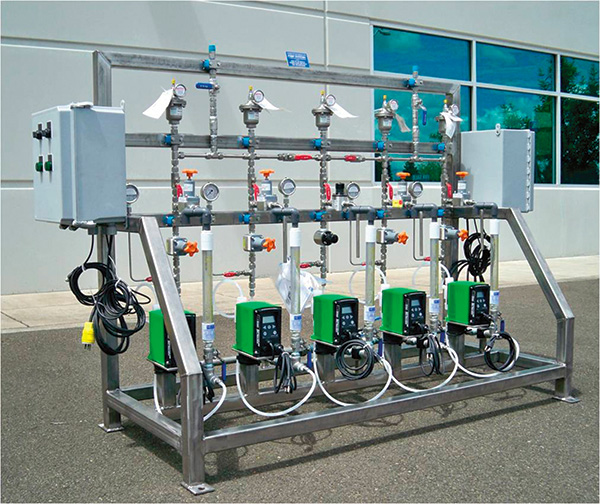
Packaged dosing system
The Importance of Packaged Dosing Systems
Dosing pumps are an important component in most large plants and systems. Several dosing pumps are often installed at a site. The key is to package the dosing systems for the greatest benefit. From the specifying engineer to the dosing system supplier, the installing contractor to the plant operator, packaged dosing systems can benefit everyone.
Packaged dosing systems have been gaining popularity during the last 10 years, but not everyone considers the advantages of packaging dosing pumps into complete systems. The advantages to specifying, supplying, installing and owning a packaged system are numerous. Dosing systems may seem complicated, but most consist of similar components and can be set up for a multitude of applications. The components of dosage systems can make the system appear more complicated. These components include:
- Small diameter pipe
- Multiple fittings
- Ball valves
- Check valves
- Unions
- Pressure relief valves
- Back pressure valves
- Calibration columns
- Gauges
- Pressure transducers
- Pumps
- Controls
However, a packaged system does not have to be complicated if it is properly installed. Every component has its correct place, and a misplaced part can be a disaster for a system. While plenty of instances of properly built, onsite dosing systems exist, many systems fail as well. In some instances, a system has been modified so many times that the owner is left with a wall of spaghetti hose. Working with a packaged system provider that specializes in packaged dosing systems can eliminate these issues while ensuring unit responsibility for the entire packaged system.
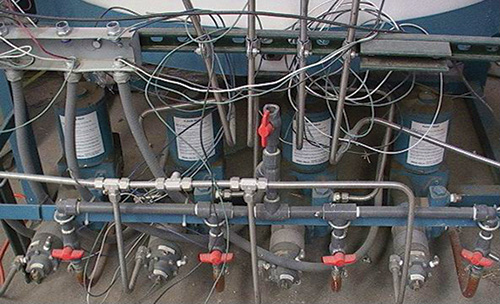
Poor installation of a packaged dosing system
Packaging the Pumps
The packaging process starts by properly engineering each system for its given purpose. Many applications at water/wastewater treatment plants, for example, require the specification of packaged dosing system can be found. Some of these include:
- pH control using caustics and acids
- Disinfection using chlorine
- Flocking using polymers
The application determines the type of pump and the material of construction. Operators should look for opportunities in the engineering stage of a plant that is being built or upgraded to specify a packaged dosing system. They should work with a packaged system supplier from the beginning to determine the best system configuration and the best pump choice.
Packaged dosing systems may use many different pump types. The most common are diaphragm pumps and peristaltic pumps. These positive displacement pumps can meter or dose a broad range of flow rates through the use of a stroke controller or a variable frequency drive while maintaining the required system pressure (psi). As with any pump, proper sizing is important to ensure that the pump will cover the flow and pressure range required to accurately introduce the chemical into the process stream. A company that builds packaged dosing systems will be able to help an operator correctly select and size the pumps for each application. 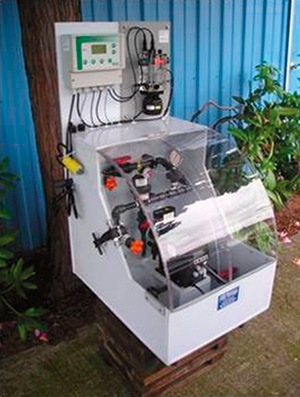
A packaged hypochlorite system
Chemical Compatibility
The chemical compatibility of a dosing system is also important and, if not considered up front, can be costly to repair. For instance, if the diaphragm material on a sulfuric acid system is ethylene propylene diene monomer, a catastrophic failure can be expected in as little time as one month after startup. The proper material selection would be synthetic rubber and fluoropolymer elastomer or polytetrafluoroethylene (PTFE) diaphragms with Alloy 20 or polyvinylidene fluoride or polyvinylidene difluoride pipe.
Similarly, using a 316 stainless steel pipe in a sodium hypochlorite system can cause major damage. Chlorinated polyvinyl chloride or polyvinyl chloride pipe with synthetic rubber and fluoropolymer elastomer or PTFE elastomers would always be recommended.
With hypochlorite, an important concern is gassing off. This is what can happen to hypochlorite when the system is not operating or the flow does not move through a section of pipe. Gas will form in the line and build up in the pumps and valves. This gas can create so much pressure that it can damage the pump and ball valve. A dosing system packager will know that the pumps moving hypochlorite should be equipped with automatic gas reliefs, and the ball valves must be vented to allow the gas to pass out of the ball when in the closed position. If these gas reliefs are not included, gas can build up in the ball and crack the stem, causing the hypochlorite to leak.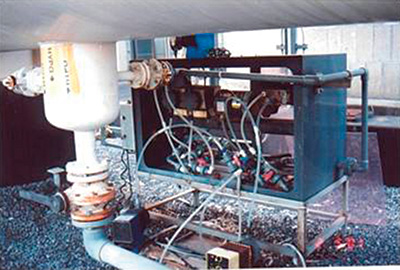
A sodium hypochlorite system built on site
System Layout
Working with a packaged dosing system provider will also ensure that the piping is laid out correctly and is as compact as possible. When a pump system is engineered as a package, keeping the footprint as small as possible is usually a requirement. This is a double-edged sword since there is a fine line between functionality and compact design.
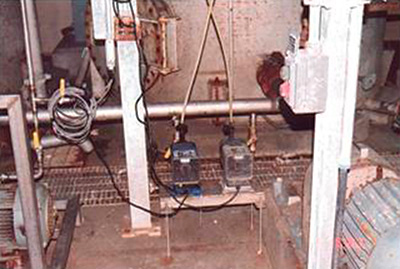
Built on site
Most dosing packagers have learned to take this into account when designing their skids, but engineers, owners and suppliers must inform the system provider of any space or obstacle restrictions at the site. Let the provider know on what side of the skid the control panel should be mounted if an obstruction, such as a structural post, must be navigated. When the package is laid out properly, all the pumps, valves and instrumentation should be easily accessible from the front of the skid.
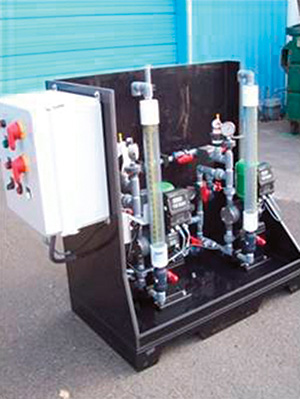
Duplex pump package
Using the expertise of a reputable packaged dosing system provider can open many opportunities to engineer, supply, install and own a more reliable dosing system. Packaged dosing pump systems will ensure unit responsibility for the chemical feed system and provide technical support, startup services and a system inclusive warranty. Therefore, when working on a municipal or industrial pump project, do not forget about the dosing system. P&S

